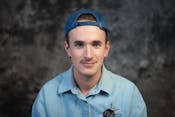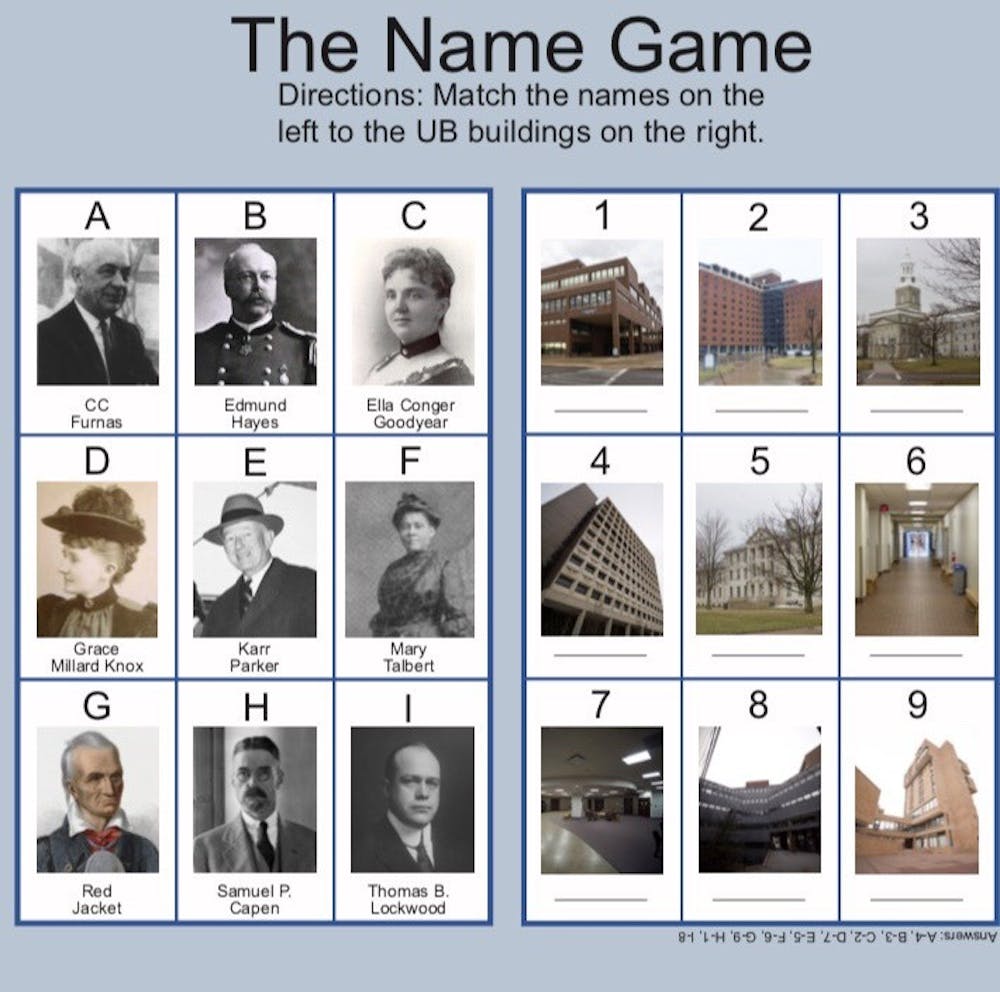Most students don’t know former UB President Clifford Furnas was an Olympian.
Or that Carolyn Tripp Clement might have made the first local phone call in Buffalo.
But, if you ask students where their buildings are, their last names roll off the tip of the tongue.
For many UB community members, a building or space name doesn’t mean much. SUNY has policies for naming campus spaces, so UB’s policy is not unique. And as more schools evaluate the difficult histories of named spaces, UB has yet to strip a building name due to a person’s past. When UB demolishes or sells a space named in someone’s “honor,” UB spokesperson Cory Nealon said UB does not have a formal process to reuse those names, either.
The Spectrum found that most donation-based names happened after the year 2000, whereas most “honorific” (or non-donation-based) names happened during the construction of North Campus in the 1970s. UB has named at least 422 spaces, while at least 32 spaces have been demolished or replaced over time.
But when it comes to current names around campus, minorities only share a portion of the UB landscape.
The Spectrum found only 21 campus spaces named after people of color.
At least 26 spaces are named after women and at least 185 spaces are named after men.
Currently, the UB Council and UB President Satish Tripathi are in charge of approving names before they head to SUNY for approval. Over the past half century, UB committees have suggested hundreds of names to the UB Council. A “Building and Landscape Naming Committee” recently met to discuss new policies for “honorific” (or non-donation-based) names on campus, according to Nealon.
The Spectrum talked to dozens of students but all needed hints to guess the people behind UB buildings and spaces. The Spectrum spent a month analyzing the UB Archives and journeyed around campus to confirm the existence of rooms and spaces. Many faculty and staff declined to talk to The Spectrum or said they had no idea about the names behind the rooms they work in. Many students said they’d like to know more about UB’s roughly 173-year history and would like more community members to take an active role in campus history.
“In the [1970s,] there was a lot more public engagement in the [naming process],” said Michael Brown, UB Council student representative. “I think that type of spirit of shared governance, a collaborative approach to shaping the spaces around us, that’s a great example we should always strive to even out-do that.”
The naming process
There are two types of reasons for UB names: donations and honors.
For some donors, their names can appear on buildings because of a $1 million-plus gift to UB. The donor will talk with the vice president for university advancement in this case, Nealon said. The UB VP sends the name to the UB president, who then decides whether to make a recommendation to the council. Once the council approves a name, it goes to the SUNY Chancellor and Board of Trustees for the final decision, Nealon said.
This process is slightly different for “honorific” names. These names have “historically” involved ad-hoc internal committee recommendations, Nealon said. The UB president approves a committee’s recommendation, followed by the council and then SUNY.
The Spectrum looked at over 300 council meeting minutes with the help of UB Archives. The records we found showed council members approved every proposed naming resolution.
And just as the UB namescape is mostly male, the council has been mostly made of men since 1963. Just 20 of the 87 council members since 1963 have been women.
The council has also historically voted on spaces named after active members.
Former council member Gerald Lippes decided to abstain from voting on a resolution to name Slee Hall’s auditorium after himself and his wife in 2003. The late Dr. Edmond Gicewicz also sat in Capen Hall’s council room as the council voted to name the UB Athletics Hall of Fame after him in 2007. And in 2015, council members applauded the new naming of the Jacobs School of Medicine and Biomedical Sciences as council chair Jeremy Jacobs sat at the table’s head.
And UB isn’t unique in honoring donations either, as other college campuses and organizations honor $1,000-plus gifts with everything from stones to plaques on “donor walls.” The Lippes family, the Jacobs family and the Gicewicz family all donated money to the university, which led to the named spaces.
There aren’t guidelines that restrict council members from naming things after themselves. UB hasn’t stopped this practice but it has removed donated names from offices due to the person damaging UB’s image.
In 2009, UB donor and former UB Foundation board member Stephen Walsh, a ‘66 alum, was charged with defrauding more than $500 million in client investments in 2009, according to Buffalo Business First. UB named the Walsh complex in Alumni Arena after his donation in 2001. Nealon said UB removed the name after his conviction and returned the donated funds.
UB policy allows officials to remove the name of John and Edith Kapoor Hall. The couple’s roughly $10.8 million donation helped support the building in their name. John Kapoor, founder of Insys Therapeutics, is currently on trial for an alleged conspiracy to bribe doctors into prescribing opioids to patients.
A usable past
UB broke ground on North Campus in October 1968.
The result was an increase in buildings, rooms and spaces, all awaiting names.
UB formed a naming subcommittee to assist the council with the difficult task. UB Archives show the subcommittee collected records such as biographies, newspaper articles and even descendents of potential namesakes.
UB Archives show that the subcommittee consulted former UB archivist Shonnie Finnegan throughout the ‘70s too. Finnegan said she recommend a number of names, such as Grace Knox and Cornelia Allen, which still appear on campus buildings.
She also recommended Samuel P. Capen’s name move to North Campus.
The first naming subcommittee released its naming criteria in May 1972. The criteria called for names in honor of deceased people, living people (in “rare exceptions”) and names with a “significant” connection to UB and Western New York.
Earlier drafts in the UB Archives reveal redacted versions of the criteria. The subcommittee removed clauses that would call for names of “persons representative of ethnic groups.” They also scribbled out a clause that would call for buildings named after the Haudenosaunee nations.
The committee approved a clause that states names shouldn’t be “excluded” on the basis of race.
Dr. Lillian Williams, a Transnational Studies professor, wrote to the old naming subcommittee about the importance of Mary Talbert, a prominent black leader in the late 19th and early 20th century.
Williams used to teach at Howard University where she said there was a “sense of pride” in buildings named after people like Frederick Douglass.
Williams said naming is important at UB for the same reasons.
“I’ve taught in Mary Talbert Hall and I’ve had the same sense I did when I was teaching in Douglass Hall,” Williams said. “But my students didn’t know who Talbert was, I told them all about [her]. It didn’t matter what course I was teaching, they still had to know why they were in Mary Talbert Hall.”
The Transnational Studies department celebrated 50 years of UB’s Black Studies department and program earlier this month. Williams said students took part in an essay contest at the event and, when she heard the essays, the amount of “alienation that they felt” at UB was “striking.”
She said buildings, in this way, could give those students a feeling of belonging at UB.
The old subcommittee also ran advertisements that asked for naming suggestions in local newspapers, according to UB Archives. Today, current UB Council members and the UB President have not done similar outreach to look for new names.
In the past two months, The Spectrum reached out to a number of UB employees for help gathering information on historic UB names.
David Barnas, UB Facilities’ senior physical space administrator, sent The Spectrum a list of all named buildings owned and leased by UB. Other employees such as Robin Comeau, quality assurance coordinator in the School of Dental Medicine, could identify rooms in their workplace.
Most employees The Spectrum talked to, however, said they did not know UB history or declined to comment.
Spectrum editors walked around Dr. Charles Cary Hall to find the purported Dr. Willard B. Elliott Room (101A) locked from the outside. In 1981, the UB Council approved a room in honor of Elliott, a UB biochemist for three decades. A neighboring employee to 101A said he never heard of Elliott and the room was used for “storing computer monitors.”
Nealon said there currently isn’t a formal process for reusing old names and the new naming committee is set to create its own guidelines.
“Perhaps historic figures … could be considered when future honorific naming opportunities arise,” Nealon said.
The Spectrum could not find information on many of the named spaces online, but most name information is in the UB Archives.
UB reference archivist William Offhaus said UB Archives has helped schools, departments and offices seeking historical information on the university. The archives also instructs classes on UB history and teaches students how to perform archival research.
Victoria Wolcott, chair of the history department, said the department does not have a historian on staff who focuses on UB or local history.
“We have faculty who could provide historical context on the figures that are used for naming buildings,” Wolcott said. “Hiring a faculty member who specializes in public history and has knowledge of local history would be valuable to our students. But we currently don’t have the resources available to do so.”
Historians such as Julian Park, first dean of the College of Arts and Sciences, wrote about UB’s history up until his death in 1965, according to the UB Reporter. The history, first published in 1917, is available online. Former UB President Bill Greiner and former UB Provost Thomas Headrick also wrote an updated version of university history in “Location, Location, Location” in 2007.
Finnegan said she is unsure just how often people are inspired when they walk into named buildings and spaces, but if they truly care about something, they will feel very close to that history.
“The majority of students and community members are not going to delve into the published works on UB history or go into the archival records, so I think there are other ways besides buildings and spaces to [honor] the past,” Finnegan said.
“To me it’s beneficial in an institution to have some kind of a tradition. Samuel Capen often talked about the tradition of ‘academic freedom’ and the people that brought his name here to [North Campus] did support that. I believe this is still honored.”
Brown said it would be helpful to know the current situation of name representation and the histories of names on campus.
“I think making people aware of that would obviously be helpful,” Brown said. “Regardless of what the current ratio and breakdown of representation is, there’s always room for improvement.”
The UB Council, which can suggest future names, is expected to meet in the Buffalo Room on Monday, March 4 at 8 a.m.
Benjamin Blanchet is the editorial editor and can be reached at benjamin.blanchet@ubspectrum.com and on Twitter @BenjaminUBSpec.

Benjamin Blanchet is the senior engagement editor for The Spectrum. His words have been seen in The Buffalo News (Gusto) and The Sun newspapers of Western New York. Loves cryptoquip and double-doubles.





